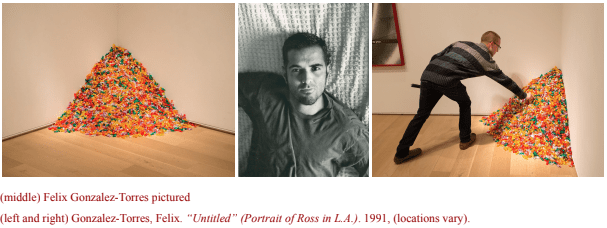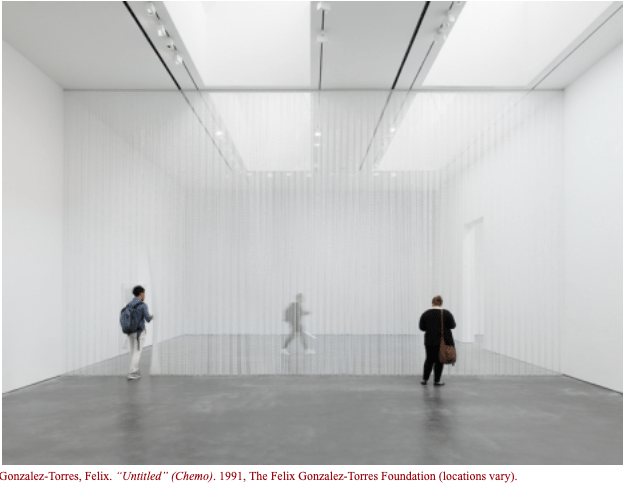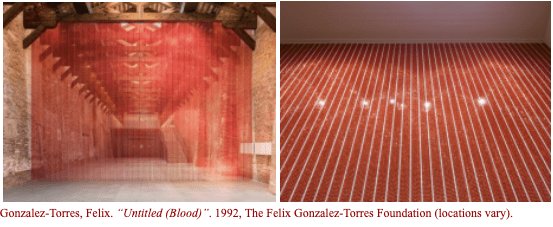Felix Gonzalez-Torres: Behind the Curtain
By Danielle Haniph
Today, Felix Gonzalez-Torres (pictured below in the middle) is an artist widely known for his metaphorical minimalist and neo-conceptualist artworks. Born in 1957 in Guáimaro, Cuba, Gonzalez-Torres lived in Spain and Puerto Rico, until he moved to New York in 1979. In 1983, he received his BFA (Bachelor of Fine Arts) in photography at Pratt Institute. Later that year, Gonzalez-Torres received his MFA (Master of Fine Arts) from New York University (NYU) and the International Center of Photography. As an openly gay man, Gonzalez-Torres was actively involved in social and political movements throughout his artistic career. For example, in 1987, Gonzalez-Torres helped found Group Material (1987-1991), a group of conceptual artists that initiated cultural education and activism in American society. In 1991, at the start of his popularity as an artist, Gonzalez-Torres’s partner, Ross Laycock, died of AIDS―a loss that greatly impacted the rest of his life’s work. From that point on, a majority of Gonzalez-Torres’s metaphorical work began to tackle concepts related to AIDS. (middle) Felix Gonzalez-Torres pictured

Many scholars have concluded that Gonzalez-Torres’s work was greatly influenced by German playwright, Bertolt Brecht, and his epic theater theory, the idea in which exceptional acting and stage performances can spark social action in the audience. Sticking to minimalist and conceptualist ideas, Gonzalez-Torres used everyday objects such as beads, paper, and candy, to create sensational and interactive pieces of art that address themes such as love, death, and identity. All of his works are labeled as “untitled” followed by a phrase in parentheses that describes the meaning behind the work. Gonzalez-Torres’s work is also exceptionally unique as he invites his viewers to take pieces of his artwork to further add to the meaning behind his pieces. For example, in his most famous work, “Untitled” (Portrait of Ross in L.A.), (the candy pile sculpture pictured above on the left and right) Gonzalez Torres encourages his viewers to take a piece of candy from the sculpture until it disappears. The candy is replaced by the museum every time the pile vanishes. Through the participation of his viewers, Gonzalez-Torres’s work creates a strong message that relates to the loss of his former partner, Ross Laycock. The weight of the candy is 175 lbs, which represents the weight of an average, healthy male. Furthermore, the declining weight of the candy metaphorically represents the diminishing health of Laycock as a result of AIDS.

In addition to his candy sculpture, Gonzalez-Torres has created a variety of metaphorical artworks that resemble beaded disco curtains. These curtains are composed of a range of materials, including beads and tulle, and have been installed in different locations throughout the world. In 1991, Gonzalez-Torres created “Untitled” (Chemo), (pictured above) a stunning arrangement of white and clear beads in the form of a curtain. In the pieces’ inventory description, Gonzalez-Torres requests specific materials: “white, clear and silver plastic beads and metal rod.” Although the materials seem quite plain, they evoke a powerful meaning. The 1 sparkling assortment of the beads invites the viewer to step through the curtain. When the viewer passes through the curtain individually, he/she is hit with white visions of hospital halls and medical machines. When these visions have passed, the viewer is relieved of these painful visions, only to realize that they are left in solitude. Through these interactive experiences, Gonzalez-Torres brings the sad realities of chemotherapy to life. By walking through the curtain, viewers take on the internal conflict patients experience when they choose to do chemotherapy. Although patients may have the prayers and support of their loved ones, they begin and finish the chemotherapy process physically alone. This unaccompanied challenge takes patients through a rollercoaster of emotions, as they struggle to mentally cope with their disease and the possibility of early death. The colors of the beads in the curtain reflect the “white, clear and silver” appearances of the chemo medication itself. The sporadic placement of clear and silver beads throughout the white beads creates a sense of intrusion in the viewer, similar to the intrusion of chemo in the human body. Each line of beads acts like a portion of chemo medicine that invades the human veins.

1 Worley, Taylor. 18 May 2015. “From Hostility to Hospitality.”
https://www.curatormagazine.com/taylorworley/play-at-your-own-risk/.
In 1992, Gonzalez-Torres created “Untitled” (Blood), (pictured above) an excellent representation of blood brought to life through a curtain composed of red and clear beads. This piece embodies America’s increasing fear of AIDS in the 1990s and the blood that would be lost as a result of the disease. Through this curtain, Gonzalez-Torres creates an opportunity for viewers to experience this fear, but also to overcome it. As viewers step through the curtain, the delicate sensation of the red beads mimics the soft touch of blood on the human skin. By choosing to pass through this curtain, viewers challenge their fears related to blood and death. In the process, viewers allow themselves to become vulnerable, which will further cause them to overcome their fears and emerge from the curtain emotionally triumphant. Similar to“Untitled” (Chemo), this piece of artwork requires specific colors that reveal an interesting meaning. The curtain is composed using the following pattern: six strands of red beads followed by a single strand of clear beads. Through this pattern, Gonzalez-Torres uses the clear beads to reveal a low white blood count, a symptom commonly associated with AIDS. In doing so, the clear beads show the invasive nature of AIDS on the human bloodstream, a concept similar to the one presented in “Untitled” (Chemo).
Unfortunately, at the young age of 38, Felix Gonzalez-Torres died of AIDS in Miami, Florida on January 9, 1996. Although Gonzalez-Torres’s life was ended quite early by a brutal disease, his legacy lives on through his artwork. His metaphorical pieces have inspired millions around the world and have introduced many to the interactive nature of the visual arts. Through Gonzalez-Torres’s curtain sculptures, such as “Untitled” (Chemo) and “Untitled” (Blood), he reveals menacing themes, such as sickness and death. As Gonzalez-Torres’s artwork lives on, so does the metaphorical meaning that exists behind his curtains and works.
Additional Sources:
★ https://www.guggenheim.org/artwork/artist/felix-gonzalez-torres
★ https://www.artnews.com/feature/who-was-felix-gonzalez-torres-why-was-he-important 1234592006/
★ https://www.britannica.com/art/epic-theatre
★ https://www.theguardian.com/artanddesign/2016/may/18/felix-gonzalez-torres-playfully-t easing-deadly-serious